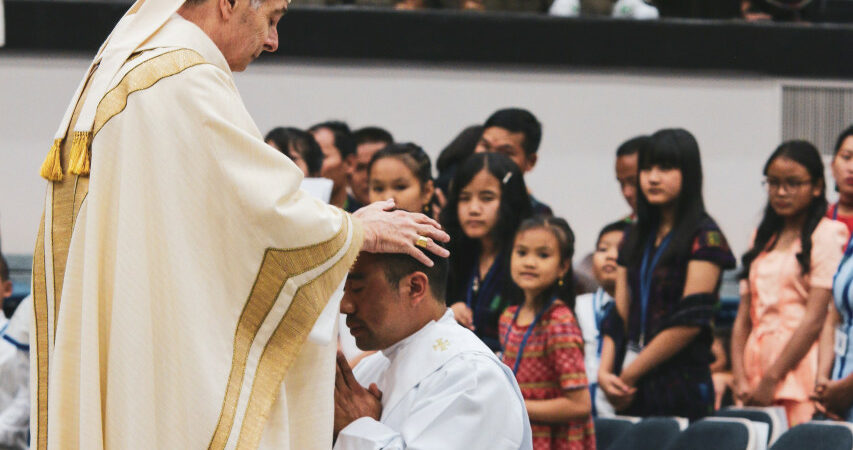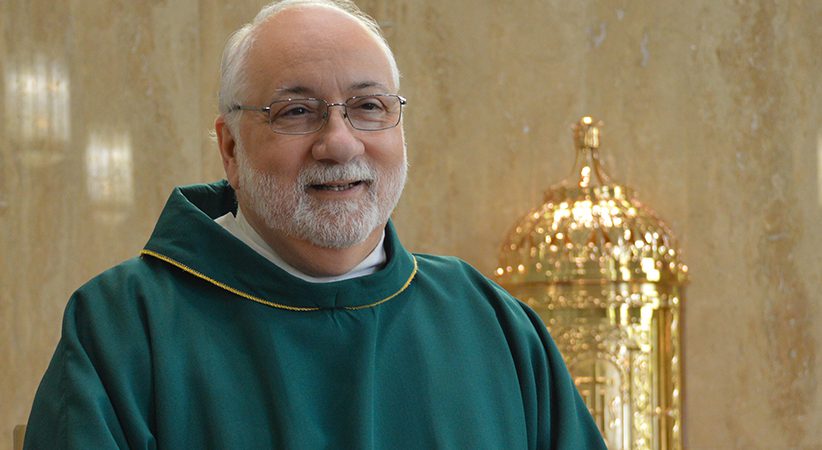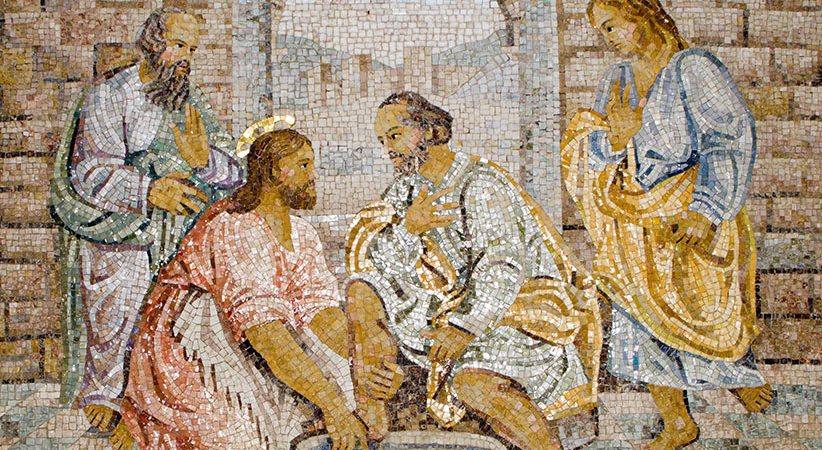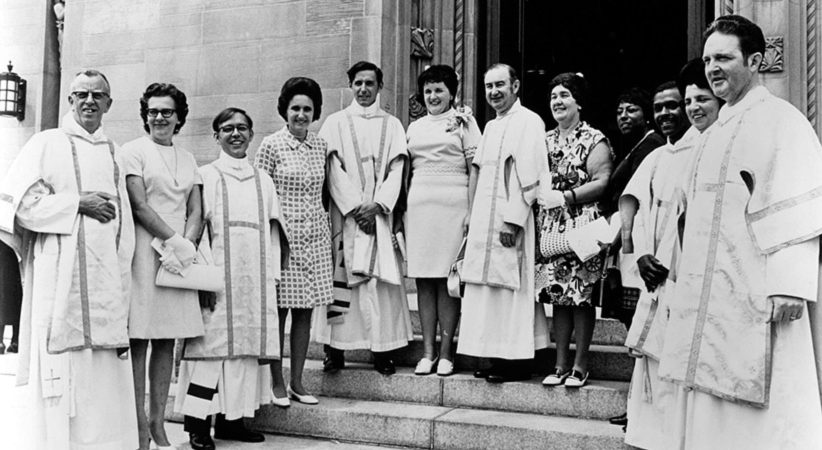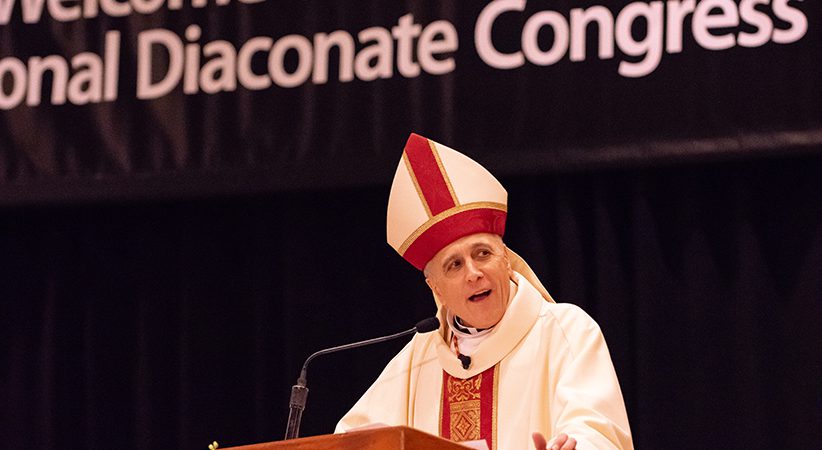Living the Sacramental Power of the Diaconate
Empowering the deacon to serve others at Mass, through the Word and in charity
Deacon Bob Rice Comments Off on Living the Sacramental Power of the Diaconate
All disciples of Jesus Christ have invisible superpowers granted to them through the sacraments. Baptism, for example, gives a person, “the power to live and act under the prompting of the Holy Spirit through the gifts of the Holy Spirit” (Catechism of the Catholic Church, No 1266). Confirmation provides a “special strength” to proclaim the name of Jesus with boldness (cf. No. 1303). Marriage gives spouses, “the grace to love each other with the love with which Christ has loved his Church” (No. 1661).
Sacraments are visible signs of invisible realities. One might compare them to the wind. Wind cannot be seen, though the effects of the wind can. In a similar way, the eye cannot perceive the difference between a consecrated or unconsecrated host. But by faith we “see” Jesus present in the Eucharist, and those who receive it faithfully with the right disposition can experience the effects of that grace in their lives.
Sadly, many Christians — even those who have received numerous sacraments — are unaware or have forgotten about the invisible powers given to them by the Holy Spirit. It can even happen to deacons.
Invisible Power of the Diaconate
There are many who carry out diaconal kinds of ministries in the Church, but that does not make them a deacon. Through his ordination, the deacon makes Christ the Servant present in a way he could not have done before, in a way that a layperson cannot.
What does an ordained deacon have that he did not have previously? The most common word the Church uses when describing that power is strength. The Catechism states, “Deacons receive the strength to serve the people of God in the diakonia of liturgy, word, and charity, in communion with the bishop and his presbyterate” (No. 875). The Second Vatican Council wrote that, through their ordination, deacons would be, strengthened “by the imposition of hands which has come down from the Apostles” and that “their ministry would be made more fruitful through the “sacramental grace” (Ad Gentes, No. 16).
As a deacon, one has the strength to do things he could not have done before. It is important that he knows that and calls upon that strength. Obviously, we are not talking about physical strength, like one would see when Bruce Banner transforms into the Hulk! The strength that a deacon receives empowers him to serve others at Mass, through the Word and in charity in new and more fruitful ways.
Just as a married couple should call upon their sacramental grace to love each other more perfectly, and a priest call upon his sacramental grace to celebrate the Eucharist, a deacon should call upon his sacramental grace in order to serve as Jesus would serve, to die to self and to love others as Christ loved us. Like the love between spouses or the presence of Jesus in the Eucharist, this is an invisible reality that can bear visible fruit.
“For God did not give us a spirit of cowardice,” St. Paul wrote to St. Timothy, “but rather of power and love and self-control” (2 Tm 1:7). It is common for a young deacon, blessing his first object, to wonder, “Did that work?” Yes! It did! The authority to bless is one of the many graces given to a deacon. But if the deacon doubts that power, who else will believe it?
A deacon should not be afraid to put their new strength to the test and use that power to do something new as guided by the Holy Spirit. Many have shared about situations in ministry they considered unthinkable before, yet through the grace of the diaconate it bore fruit in ways they would not have imagined.
Though a diaconal stole might physically resemble the sash worn by the Boy Scouts, ordination is more than a merit badge given to a good Catholic man who took some classes in theology. The Sacrament of Holy Orders confers “a sacred power for the service of the faithful” (Catechism, No. 1592). But these graces, to truly bear fruit in the Church, must be “seen” as well.
Visible Reality of the Diaconate
As mentioned earlier, sacraments are visible signs of invisible realities. The water used in baptism allows one to see the washing away of sin as it is happening in the soul. Hearing the words, “I absolve you of all your sins …” allows the penitent to know the grace of forgiveness that occurs at that very moment. Other pious practices of the Church, though not necessarily a specific part of the sacramental rite, also provide tangible connections to intangible truths. One receiving confirmation gets a new name. A bride (and often groom) wears a ring. A priest wears a Roman collar.

Though one needn’t do those things for a sacrament to be valid, they are helpful in making the sacrament visible. It could be argued that the visual presentation of such sacramental realities either enhances or diminishes the faithful’s ability to participate in them. This is why Church architecture encourages a baptismal font at the entrance and the tabernacle prominently displayed behind the altar. If the baptismal font is only rolled out on Sunday afternoons or the tabernacle is located somewhere down the hall, they run the risk of becoming “out of sight, out of mind.” Not properly representing sacraments can even bring scandal. If a woman stops wearing her wedding ring, friends will be concerned the marriage isn’t going well!
The Church provides many opportunities to represent the sacramental grace of the diaconate. And it is much more than a pin on their lapel.
The most important visual for the diaconate is the “matter” of the sacrament: “a baptized man” (Catechism, No. 1577). This is not just a male who happened to be baptized as an infant, but a man who is fully living out the baptismal grace he has received to be priest, prophet and king. As mentioned earlier, through the graces of ordination he is strengthened in his service of liturgy, word and charity. A visible sign of this invisible reality is that he is called by a new title — deacon.
There are other professions that come with a new title, such as officer, professor or doctor. However, those are titles of function. The title of deacon is more than that. It is a reflection of the indelible spiritual character the man has received. It is not about what he does, it is about who he is now, thanks to the grace given by the Holy Spirit through the Church. Many lay faithful do not know that deacon means “servant,” and the sacrament would be more understood if they did.
Within the celebration of Mass, every liturgical action of the deacon is intentionally chosen to represent the spiritual reality of the diaconate, an ordained ministry that configures a man into the servant mysteries of Christ. Since the deacon serves as a bridge between the sanctuary and society, he leads liturgical actions that invite the congregation into greater participation of the Mass: the Kyrie, the Gospel, the intentions, the sign of peace. Bishop W. Shawn McKnight beautifully called deacons at Mass “ministers of the threshold,” and said of them, “As a herald of the Gospel, announcer of the intentions, assistant at the presentation and preparation of the gifts, instigator of the sign of peace, distributor of the Eucharist, and the one who missions the assembly, the deacon is ordained to symbolize Christ the servant to the assembly in a way that no one else can” (“Understanding the Diaconate,” The Catholic University of America Press, $29.95).
It would be good for the Church to more strongly advocate for the visibility of the diaconate, not just for the sake of the men who are ordained, but because of the inherent dignity of the sacrament itself. In the celebration of the liturgy, it would be most fitting if a deacon were given a dalmatic to wear. Wearing a stole over an alb makes one appear to be more of a higher rank of altar server than a lower rank of clergy.
If they have the ability, deacons should be allowed to preach, especially on Sundays. Such homiletic opportunities “show” the congregation that the Gospel they are ordained to proclaim is not just what is read from the sacred text but reflected from a holy life. Apostolorum Successores (Directory for the Pastoral Ministry of Bishops) stated, “It is very important to enable deacons, as far as possible, to exercise their ministry in its fullness: in preaching, in the liturgy, and in works of charity” (No. 93).
It would be most visually fitting for a deacon to wear a Roman collar while performing diaconal ministries, though that is a contentious issue in some dioceses. There are deacons (as there are priests) who don’t feel comfortable wearing them. However, in the United States, a Roman collar is usually representative of being ordained (or, in the case of some seminaries, in training for ordination). It can be argued that to not wear it (or to not be allowed to wear it) makes a visible statement that is contrary to the invisible reality of the first degree of the Sacrament of Holy Orders. A deacon is more than an active male member of the parish, and it is important that the faithful “see” that by what he wears.
If a deacon wears a stole instead of the dalmatic at Mass, if he proclaims the Gospel but never preaches a homily, if he wears a lapel pin but never a collar, is he less of a deacon? No, of course not. But the sacrament is less visible. And when sacraments lose their visibility, they run the risk of being diminished in the lives of the faithful.
Living the Visible and Invisible
The Catechism describes the Sacrament of Holy Orders as, “the ministry in which Christ’s emissaries [bishops, priests, and deacons] do and give by God’s grace what they cannot do and give by their own powers” (No. 875). This is important. One does not receive sacramental grace as an encouragement to keep on doing what was already being done. Surely the man ordained had already been involved in ministry, just as a man getting married had already been involved in a romantic relationship. But things change with the sacrament, both outwardly and inwardly.
In our human frailty, is it easy to focus on the visible reality: the title, the vestments, the role in liturgy, the responsibilities within the parish? A parishioner may think that is all there is to the diaconate, and a deacon himself may fall into that same line of thinking. This is the same trap that St. Paul chastised those in Galatia about by writing, “Are you so stupid? After beginning with the Spirit, are you now ending with the flesh?” (Gal 3:3). The visible points to the invisible. Even the small pin of the deacon’s cross points to a far greater reality than what can be seen by the human eye.
Like all sacramental graces, one must know about it, believe it and use it for the glory of God and the building of the Kingdom. A deacon must intentionally and frequently call upon the graces of his sacrament if he is to accomplish the new work that God has called him to do. His previous strength and abilities were not enough. It is only through that strength given to him as a deacon that he can truly say with Jesus, “I am among you as the one who serves” (Lk 22:27).
DEACON BOB RICE, Ph.D., is a professor of catechetics and the director of the Master of Arts in Catechetics and Evangelization at the Franciscan University of Steubenville, Ohio, and a deacon for the Diocese of Steubenville.
……………………………………………………………………………………………………………………………………………………
CUSTODIANS OF SERVICE
Addressing permanent deacons of the Diocese of Rome and their families on June 19, 2021, Pope Francis said: “We are all called to lower ourselves, because Jesus stooped to us, he made himself the servant of all. If there is one great person in the Church, it is the one who made him- or herself the smallest, and servant of all. And it all begins here, as we are reminded by the fact that the diaconate is the gateway to the Order. And deacons, you remain forever. Let us remember, please, that for the disciples of Jesus, to love is to serve and to serve is to reign. Power lies in service, not in anything else. And as you have recalled what I say, that deacons are the custodians of service in the Church, so we can say that they are the custodians of true ‘power’ in the Church, so that no one goes beyond the power of service. Think about this. …
“Indeed, if we do not live this dimension of service, every ministry is emptied from within, it becomes sterile, it does not bear fruit. And little by little it becomes worldly. Deacons remind the Church that what St. Theresa discovered is true: the Church has a heart enflamed by love. Yes, a humble heart throbbing with service. Deacons remind us of this when, like the deacon St. Francis, they bring God’s closeness to others without imposing themselves, serving with humility and joy. The generosity of a deacon who gives of himself without seeking the front ranks has about him the perfume of the Gospel, he tells of the greatness of God’s humility in taking the first step — always, God always takes the first step — to meet even those who have turned their backs on him.”
…………………………………………………………………………………………………………………………………………………….

